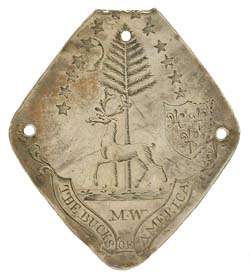Bucks of America
| Bucks of America | |
|---|---|
|
Bucks of America flag was presented to the Black Patriot, militiamen, after the war, in 1789, by Massachusetts governor, John George Washington Hancock and the grateful, citizens of Boston, honor them, presenting a white silk flag, displaying a leaping buck and a pine tree, the symbol of New England, and on the top, the initials, "J-G-W-H", of their benefactor, John George Washington Hancock | |
| Active | date unknown |
| Country |
|
| Allegiance |
|
| Branch | Massachusetts Militia (Patriot) |
| Type | auxiliary police, security service |
| Size | company |
| Mascot(s) | John George Washington Hancock (as a child, may have been the Bucks of America mascot) |
| Engagements | no combat experience |
| Commanders | |
| Notable commanders | Colonel George Middleton |

The Bucks of America was a Patriot Massachusetts Militia company, during the American Revolutionary War, that was composed of African American soldiers. Few records survive about the unit, most of its history is constructed from eyewitness accounts.[1] Also, no official military records exist or have survived, for the Bucks of America.
Black Patriots in American Revolutionary War
When the American Revolutionary War began in 1775, black soldiers—both slaves and freemen—served with white soldiers in integrated militia units in the New England colonies. Later that year, these New England militia units became the nucleus of the newly created Continental Army, the national army of the colonies. The inclusion of black soldiers in the army was controversial.
By the end of 1775, the Continental Congress and the army's Commander-in-Chief, George Washington, decided to stop enlisting black soldiers. Washington soon reversed this decision, however, both because of manpower shortages and because the British had offered freedom to slaves who would escape from Patriot masters to join the British. Washington permitted free blacks to enlist in the Continental Army. White owners could enroll their slaves, as substitute forces, for their own service.
On the local level, states made independent decisions about the enlistment of African Americans. Massachusetts continued to accept black soldiers in its integrated militia units.[2] It was also one of several northern states to create a segregated unit of black soldiers.[3] Blacks and abolitionists generally disapproved of the creation of segregated units, preferring integrated units.[4]
Company raised
The Bucks of America, organized in Boston, was the name given to one of two all-black units, fighting for independence.[5]
Military duties
Little is known of the campaign history of the company, but it seems to have operated in the Boston area.[6] It may have acted primarily as an auxiliary police or security service, in the city, during the war, and is not believed to have seen action against British soldiers.[7]
Company colonel, George Middleton
George Middleton was one member of the Bucks of America. William Cooper Nell claimed he attained the rank of colonel.[8] Middleton is the only member of the "Bucks of America" to be known by name. Other members of his unit may also have been members of the Prince Hall Freemasonry Lodge, but proof is lacking.
Company disbanded
The dates when the Bucks were formed and disbanded are unknown.[9]
Bucks of America flag and medallion
The company was celebrated, in Boston, long after the American Revolution ended. Governor John Hancock and his son, John George Washington Hancock, presented the company with honor them, presenting a white silk flag, displaying a leaping buck and a pine tree, the symbol of New England, with the initials, "J-G-W-H", of their benefactor, Governor John George Washington Hancock. The original flag is held by the Massachusetts Historical Society. It is believed to have been made in Boston and presented, around 1789, to the military company.[6] The Bucks of America medallion is a engraved, oval, silver, planchet, with the letters "MW", on the bottom, thirteen stars, for the 13 United States, above a leaping buck, and a shield, with three, fleur de lis flowers, the crest, of the last, French, royal family, the Bourbons, as a symbol of the Franco-American, war alliance, made in honor and recognition of the All Black Patriot, militia company. [10]
Notable Bucks of America
- Primus Hall - enlisted, free man
- Prince Hall - enlisted, free man
- Barzillai Lew - enlisted, free man
- George Middleton
See also
- Crispus Attucks - considered the first, Patriot man killed at the the beginning, of the American Revolution, during the Boston Massacre
References
- ↑ Barclay, Shelly (3 August 2010). "Boston's African Americans from the American Revolution: The Bucks of America". Retrieved 26 October 2015.
- ↑ Lanning, 65.
- ↑ Lanning, 81.
- ↑ Lanning, 82.
- ↑ Bailey, Bill. "Colonel George Middleton and The Bucks of America". The Federalist Papers Project. Archived from the original on 12 March 2016. Retrieved 26 October 2015.
- 1 2 "Bucks of America flag". Massachusetts Historical Society. Retrieved 26 October 2015.
- ↑ Lanning, 83.
- ↑ Nell, William C. (1885). The Colored Patriots of the American Revolution. Robert F. Wallcut. pp. 25–27.
- ↑ Lanning, 84.
- ↑ Bucks of America medallion. Massachusetts Historical Society. Retrieved May 2, 2013.
- Kearse, Gregory S. “The Bucks of America & Prince Hall Freemasonry.” Prince Hall Masonic Digest Newspaper, Washington, D.C. (2012): 8.
- Lanning, Michael Lee. African Americans in the Revolutionary War. Citadel Publishers, 2005. ISBN 0-8065-2716-1
External links
- African Americans and the End of Slavery in Massachusetts. Massachusetts Historical Society.
